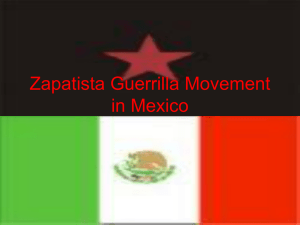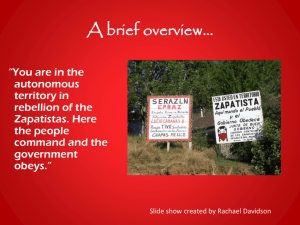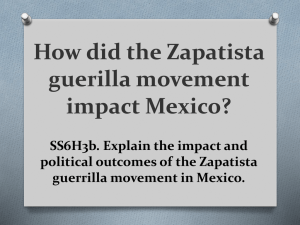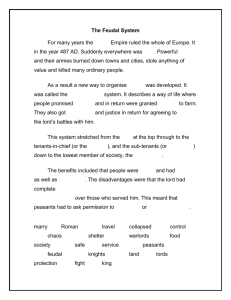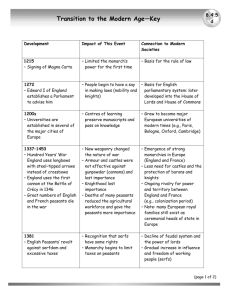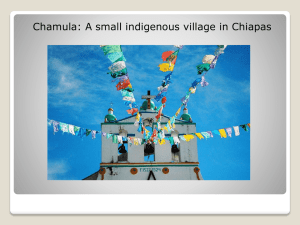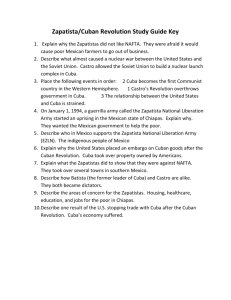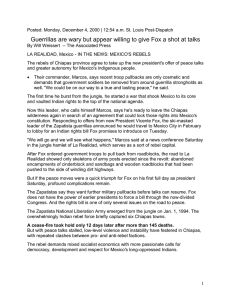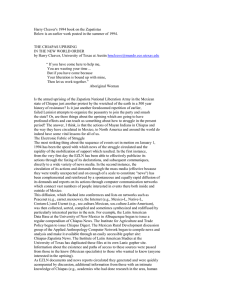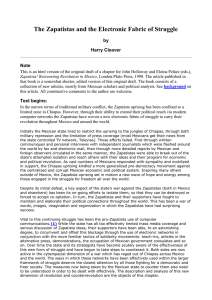Zapatista Army of Liberation (EZLN) occupies towns in Chiapas
advertisement
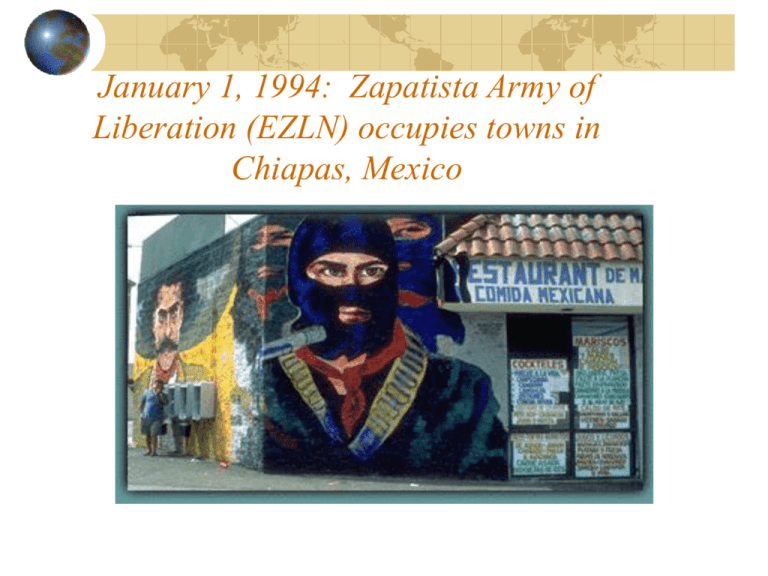
January 1, 1994: Zapatista Army of Liberation (EZLN) occupies towns in Chiapas, Mexico Social Protests Against Global Capitalism Public Demonstrations Worker Strikes Religious and Social Movements Revolution Historical Parallels? 1789-1848 “Age of Revolution” (Hobsbawm) 1830-1930 series of rebellions in Europe (Charles Tilly) Example of our own experience Civil Rights Movements (constitutional, etc.) Action Against Discrimination (religious, gender, ethnic) Anti-corporate Environmental Militia movement Religious activism (morality) Role of Global Capitalism— transformation of production, exchange & technology has produced tremendous improvements in the quality of life for a significant part of the world population Benefits are Unequal loss of land by farmers and peasants conversion to intermittent wage labor reduction of wages eradication of culture environmental degradation oppressive conditions for children What leads to revolt? Functional models—order is the normal state of society; disorder can be attributed to marginaliztion of certain sectors of society (the poor, ethnic groups, etc.) Conflict and crisis are inherent in capitalism protests are natural consequence not spontaneous but organized, directed activity of those with common interests movements may become violent, but violence is usually initiated by authorities Indigenous people (5% of world population) populations composed of different ethnic or racial groups descendants of the earliest populations which survive in the area do not as a group control the national government defined in relationship to the state (Maybury-Lewis) Characteristics of Indigenous People Mobile—cross boundaries important to the state Community ownership of resources Kin-based social structures Relatively egalitarian—reduced emphasis on consumption, marking status with possessions Control land valuable to the state State actions towards indigenous people—transfer of resources from indigenous people to state sponsored settlers (John Bodley) Pattern of Intervention Exploit ambiguity of border situations Military intervention Extension of government control to break local political autonomy direct rule indirect rule—exploit or create local leaders base camps system— relocate, integrate into trade networks Land policy—regulation, alienation, individual ownership Cultural modification Education (require or forbid) Economic Development— integration into national economy, taxation, cash economy Example 1 Malaysia and the Weapons of the Weak Research of James Scott (1985) Weapons of the Weak Focus on violent protest obscures everyday resistance Subtle actions enable poor and weak to resist rich and strong Micropractices Embodied Actions Malaysian Green Revolution 1966: World Bank funds Mudra irrigation project on Kedah Plain Peasants are able to double the harvests, extend irrigation to new land Production doubles, Unemployment reduced, Profit grows from 10% to 18% Village Benefits Infrastructure, markets, personal possessions Poorest peasants able to produce enough for families Infant mortality and malnutrition reduced by 50% Debt managed, small landholders maintain land Social Structure Changes Increased differentiation between rich and poor Social response to poverty changes Modern management erodes traditional practices, obligations Loss of cash from labor exchange Erosion of non-market cultural relations (gift-giving, feasts, etc.) Interpreting Change Double cropping and increased yield makes land more valuable local peasants cannot pay rent rich peasants keep and utilize land once rented because of profitable returns rend due in advance, discounts not negotiated Wealthy farmers have access to new technology—less peasant labor necessary Gift giving and charity from rich decreases— obligations ignored—“the freedom of the unemployed and redundant (Scott)” Resistance (Scott) Any acts by members of a subordinate class that are intended to mitigate or deny claims (rents, tax, prestige) made on that class by superordinate classes (landlords, large farmers, state) or to advance its own claims (work, land, charity, respect) vis-à-vis those superordinate classes Cultural models—folktales, performances emphasize evasiveness and cunning “Work the system to their minimum disadvantage”—Hobsbawm Gossip and Character Assault Theft (seen as substitute for charity) Sabotage Collective refusals Zapatista Rebellion Obstacles to Resistance… Who sets the limits? Velocity—is there time to respond? Can the protest be heard? Will hearing produce a response? Understanding the Moment January 1, 1994: Mexico’s entrance into NAFTA “NAFTA was the death certificate of the indigenous peoples of Mexico” —Sub-Commandant Marcos Why Zapata? Emiliano Zapata Revolution of 1910—move to reestablish communal land holding Earlier loss of peasant land Juaraz gives individual title to land—soon lost to peasants Diaz (1876-1910) sells huge tracts to investors to attract capital Chiapas Southernmost state in Mexico Poorest State Highest malnutrition, illiteracy rates 20% population has no income 40% has an income less than minimum wage Small number of wealthy families dominate economy and politics History of Repression in Chiapas During revolutionary era, local private armies maintained control through terror 1916-Federal Army repelled by Chiapas militias, land reform stifled 1993-land held by 6000; 2 million peasants Rigid control by ruling PRI—Mayan community repeats hierarchies Dissent suppressed by vigilantes The Crisis Intensifies Mayan farmers resettled in deforested areas No title to land—harassed by vigilantes Protestants harasses by Catholic establishment Modernization projects (dams, oil drilling) yield uneven benefits Causes of Poverty Communally held land can be sold (Constututional Change) NAFTA approved Decline of agricultural subsidies for poor farmers Need for peasant agriculture rethought as part of restructuring debt (1982) Fertilizer subsidy removed Coffee price supports removed Zapatista Tactics Struggle over legitimacy—Zapatistas subvert gov’t authority by using rhetoric of the revolution Traditional appeals Use of technology (internet, media) Responses to the Zapatistas Government Restraint—military response prevented by media coverage Global financial community—Zapatatistas are a hazard to confidence in Mexican markets and must be removed Can government financial aid reach the needy? Danger of vigilantes—1997 massacre of 45 Zapatista sympathizers Zapatista Information www.ezln.org www.fzln.org.mx
